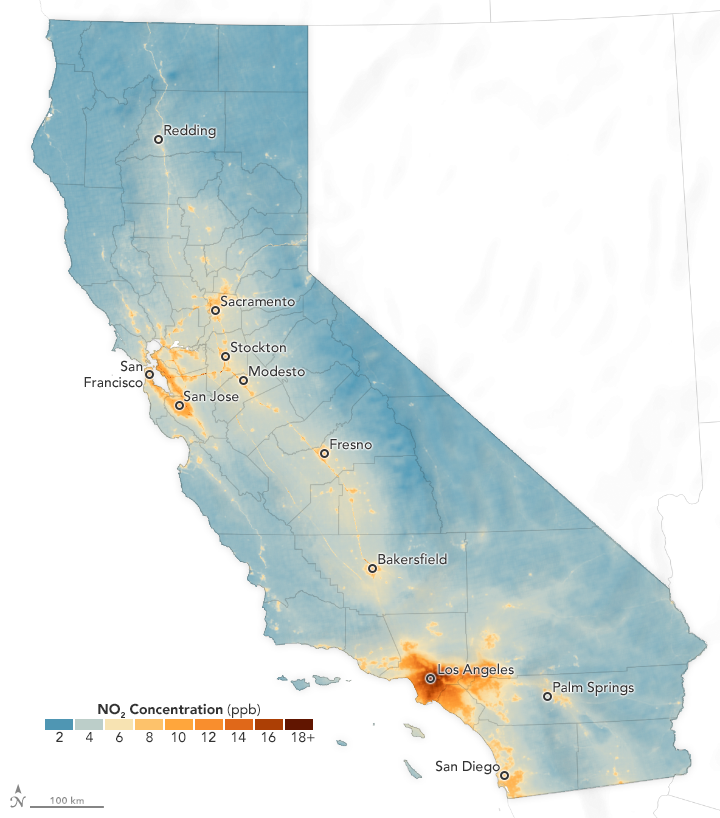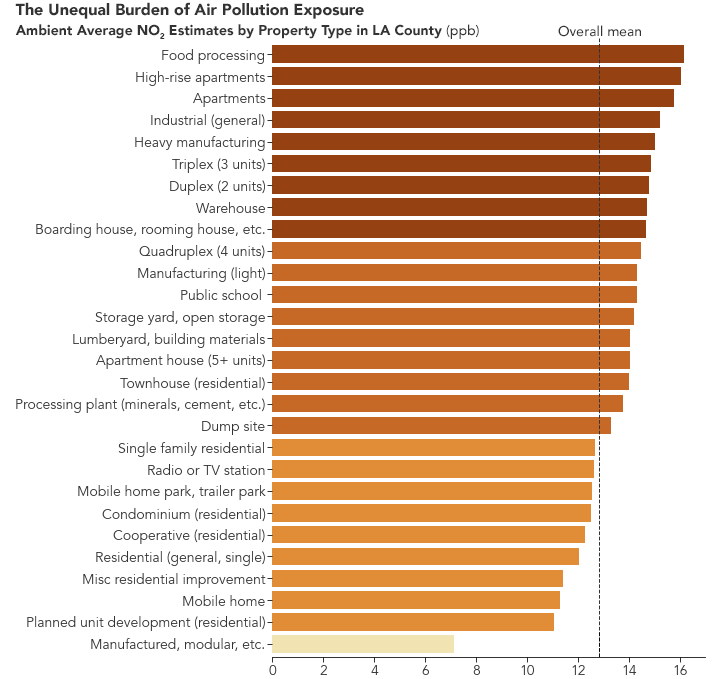


The skyline of Los Angeles is frequently shrouded in a reddish-brown haze—a visible layer of air pollution that makes it difficult to see more than a few miles in any direction. One component of this smog is nitrogen dioxide (NO2), a pungent air pollutant that irritates airways and is associated with pediatric asthma.
Using ground instruments and data from the Tropospheric Monitoring Instrument (TROPOMI) on the European Space Agency’s Sentinel-5P satellite, a team of scientists has mapped the amount of nitrogen dioxide in California’s air, down to a neighborhood scale. The team also quantified the concentrations near different types of properties within these neighborhoods.
Dark orange areas in this map show where nitrogen dioxide concentrations were highest in 2018 and 2019. The urban population hubs of Los Angeles, San Jose, and San Francisco clearly stand out as having high concentrations. Corridors of high nitrogen dioxide concentrations are also visible along major thoroughfares in the state: State Route 99, Highway 5, and Highway 101.
Cars and trucks are a major source of nitrogen dioxide as a byproduct of fossil fuel combustion, so high levels of the air pollutant near roadways are not surprising. But the team also found high levels of nitrogen dioxide near other types of infrastructure in Los Angeles County.

“We found hotspots of nitrogen dioxide near food processing facilities and high-rise apartments—those over 10 stories tall,” said Hyung Joo Lee, an air quality scientist and assistant professor at Pohang University of Science and Technology (POSTECH) in South Korea. Lee previously worked at the California Air Resources Board and had been a postdoctoral researcher at NASA’s Ames Research Center. Lee’s research is focused on using remote sensing to estimate nitrogen dioxide and other air pollutants.
Traffic-related emissions contributed to some of the nitrogen dioxide in the air near high-rise apartments. But even after factoring in the high density of vehicles, the air near high-rise apartments still contained significantly more pollution than other infrastructure. Fossil fuel burning appliances within buildings, such as space heaters, water boilers, and natural gas stoves and ovens, are likely contributors to this nitrogen dioxide, noted Robert Chatfield, an atmospheric scientist at NASA Ames and a co-author of the study.
Nitrogen dioxide pollution has been reduced in many U.S. cities in recent years, including in Los Angeles. But the pollutant continues to contribute to particulate pollution and the chemical reactions that make ozone, which are the leading causes of air pollution-related death. Chatfield noted that the findings of this research indicate that high-density residential areas may need to be monitored for hazardous pollutants.
Monitoring air pollution is expected to get easier with the launch of a forthcoming geostationary satellite, Tropospheric Emissions: Monitoring of Pollution (TEMPO). Hourly daytime observations from TEMPO will allow scientists to see how concentrations of pollution—such as nitrogen dioxide and ozone—change over the course of a day depending on temperature, wind, traffic patterns, and other phenomena. The satellite will also give scientists a better understanding of pollution sources and the burden of its health impacts on various communities.
NASA Earth Observatory images by Joshua Stevens, using data from Lee, H.J., Liu, Y., & Chatfield, R.B. (2023). TROPOMI NO2 data can be accessed via NASA’s Earthdata Search and at NASA’s Goddard Earth Sciences Data and Information Services Center (GES DISC) via cooperative agreement with the European Space Agency (ESA). Story by Emily Cassidy.